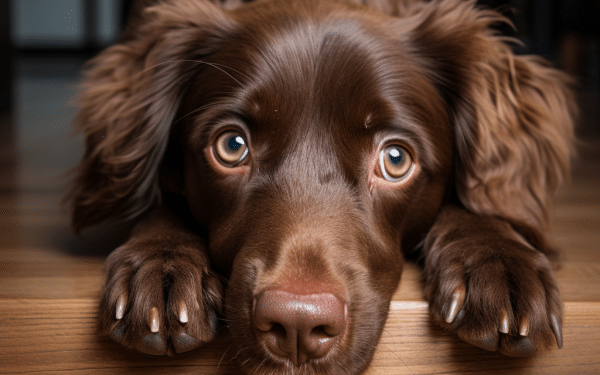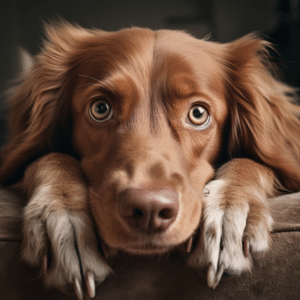Effective Coping Strategies for Fearful Dogs

Welcome to our article on aiding fearful and anxious dogs. As pet owners, it’s crucial to address these issues to support our canine friends’ well-being, behavior, and happiness.
In this article, we’ll discuss coping strategies for dogs with fear and anxiety. We’ll delve into causes, symptoms, creating a secure space, using positive reinforcement and desensitization training, seeking professional assistance, and including exercise and mental stimulation.
Just like humans, dogs can experience fear and anxiety in different situations, whether it’s triggered by loud noises, unfamiliar environments, or social interactions. It is crucial for us to recognize these signs and provide appropriate guidance and support.
By addressing these issues, we can help our furry friends lead happier, healthier lives. So let’s dive in and discover effective ways to support our dogs in coping with fear and anxiety.

Understanding Fear and Anxiety in Dogs
Fear and anxiety can significantly impact a dog’s overall well-being and quality of life. It is essential for pet owners to understand the causes and symptoms of fear and anxiety in dogs in order to provide effective coping strategies. Fearful dogs may display a range of behaviors and reactions, such as trembling, panting, aggression, excessive barking, or withdrawal.
One way fear and anxiety can manifest in dogs is through phobias, which are specific fears of certain objects or situations. Common phobias in dogs include thunderstorms, fireworks, and separation anxiety. Dogs may also experience general anxiety, which is characterized by persistent worry or unease. This can be due to past traumatic experiences, lack of socialization, or genetic predisposition.
It’s important to note that fear and anxiety in dogs are not always triggered by external factors. Medical conditions such as hormonal imbalances or cognitive decline can also contribute to a dog’s overall anxiety levels. By understanding the various causes and manifestations of fear and anxiety in dogs, pet owners can develop customized coping strategies to help their furry companions lead happier and more balanced lives.
“Fearful dogs may display a range of behaviors and reactions, such as trembling, panting, aggression, excessive barking, or withdrawal.”
Building Trust and Establishing a Safe Environment
Coping with fear and anxiety can be particularly challenging for dogs, especially those who are naturally more fearful. To help them overcome their fears and live happier lives, it is essential to create a safe and secure environment for them. Building trust with fearful dogs is a crucial step towards reducing their anxiety and ensuring their overall well-being.
Creating a Safe Space
One effective strategy is to provide a designated safe space where your dog can retreat to when they feel anxious or overwhelmed. This can be a specific room or area in your home that is equipped with their favorite toys, comfortable bedding, and familiar scents. It’s important to ensure that this space is quiet, calm, and free from any potential triggers that may cause fear or anxiety.
Positive Reinforcement
Another way to build trust with fearful dogs is through positive reinforcement. Rewarding them for calm and confident behavior can help them associate positive experiences with situations that previously caused fear or anxiety. Use treats, praise, and gentle petting to encourage and reinforce their confidence and bravery.
| Tips for Building Trust with Fearful Dogs |
|---|
| Be patient and understanding |
| Use rewards and positive reinforcement |
| Avoid forcing them into uncomfortable situations |
| Allow them to approach new experiences at their own pace |
Gradual Exposure
When introducing fearful dogs to new experiences or potential triggers, it’s important to do so gradually and at their own pace. Pushing them too quickly into uncomfortable situations can worsen their anxiety. Start by exposing them to low-intensity versions of their triggers and gradually increase the intensity over time, always ensuring they are comfortable and not overwhelmed.
By building trust and establishing a safe environment, you can help your fearful dog feel more secure and confident. Remember to be patient, use positive reinforcement, and allow them to progress at their own pace. With time and the right support, they can overcome their fears and live a happier, anxiety-free life.
Positive Reinforcement and Desensitization Training
When it comes to helping fearful dogs cope with their anxieties, positive reinforcement and desensitization training techniques have proven to be highly effective. These methods focus on rewarding desired behaviors and gradually exposing dogs to their fear triggers in a controlled and supportive environment.
Positive reinforcement involves providing rewards, such as treats or praise, when the dog displays calm and relaxed behavior. By associating positive experiences with situations that previously caused fear or anxiety, dogs can learn to feel more comfortable and confident in those scenarios.
Desensitization training involves gradually exposing the dog to the fear trigger in a way that doesn’t overwhelm them. This could involve starting with a very mild version of the trigger and gradually increasing the intensity or duration over time. For example, if a dog is afraid of loud noises, such as fireworks, the training may start with playing a recording of fireworks at a low volume and gradually increasing the volume as the dog becomes more comfortable.
Implementing Positive Reinforcement and Desensitization Techniques
- Create a calm and controlled environment for training sessions.
- Identify the specific fear triggers and start with the least intense version.
- Reward the dog with treats, praise, or playtime when they display calm behavior.
- Gradually increase the intensity or duration of the fear trigger over multiple training sessions.
- Monitor the dog’s reactions and adjust the training accordingly to avoid overwhelming them.
- Consistency and patience are key in helping the dog build confidence and overcome their fears.
By using positive reinforcement and desensitization techniques, dog owners can help their fearful companions develop coping strategies and gradually reduce their anxiety over time. It is important to note that each dog is unique, and what works for one may not work for another. Seeking guidance from a professional dog trainer or behaviorist can provide valuable insights and individualized training plans tailored to the specific needs of the dog.
| Coping Strategies for Fearful Dogs | Description |
|---|---|
| Positive Reinforcement | Rewarding desired behaviors with treats, praise, or playtime to associate positive experiences with fear triggers. |
| Desensitization Training | Gradually exposing the dog to fear triggers in a controlled and supportive environment to reduce anxiety. |
Seeking Professional Help and Therapy Options
For dogs with severe fear and anxiety issues, it is crucial to seek professional help and explore therapy options. While some cases can be managed with coping strategies at home, others may require the expertise of a trained professional to provide the necessary support and guidance.
Behavioral Therapy
One effective therapy option for fearful dogs is behavioral therapy. This approach involves working with a professional animal behaviorist or trainer who can assess the dog’s behavior, identify triggers, and develop a tailored treatment plan. Behavioral therapy focuses on gradually exposing the dog to their fears in a controlled environment, using positive reinforcement techniques to encourage more positive associations and reduce anxiety.
Medication
In some cases, medication may be recommended by a veterinarian to help manage a dog’s fear and anxiety. Anti-anxiety medications and antidepressants can help alleviate the symptoms and provide a calmer state of mind, allowing the dog to better cope with their fears. It is essential to work closely with a veterinarian to determine the appropriate medication and dosage based on the dog’s individual needs.
Seeking professional help and exploring therapy options is crucial for dogs with severe fear and anxiety issues.
It is important to note that professional help should not replace the implementation of coping strategies at home but rather complement them. Working with a professional can provide valuable insights and techniques specific to the dog’s needs, helping to address their fears and anxieties more effectively.
| Therapy Option | Description |
|---|---|
| Behavioral Therapy | Working with a professional behaviorist or trainer to develop a tailored treatment plan and gradually expose the dog to their fears in a controlled environment using positive reinforcement techniques. |
| Medication | In some cases, a veterinarian may recommend the use of anti-anxiety medications or antidepressants to alleviate symptoms and help the dog cope with their fears. |
Coping Strategies for Fearful Dogs: Incorporating Exercise and Mental Stimulation
When it comes to helping fearful dogs overcome their anxiety, incorporating exercise and mental stimulation into their daily routine can play a crucial role. Physical activity not only helps burn off excess energy but also promotes a sense of well-being. Mental stimulation, on the other hand, engages their minds and distracts them from anxious thoughts. Here are some practical suggestions for suitable activities and games that can benefit fearful dogs:
1. Interactive Toys:
Provide your dog with interactive toys that require problem-solving or offer rewards. These toys can keep them engaged mentally and help redirect their focus from fear and anxiety. Examples include treat-dispensing puzzles, Kong toys filled with peanut butter or frozen broth, and hide-and-seek games with their favorite treats.
2. Nose Work:
Engage your dog’s natural sniffing instincts by setting up scent games or nose work activities. Hide treats or toys around the house or create a scavenger hunt in the backyard. This not only provides mental stimulation but also builds their confidence as they successfully find hidden treasures.
3. Training Exercises:
Regular training sessions can be highly beneficial for fearful dogs. Focus on positive reinforcement techniques to build their confidence and reinforce positive behaviors. Start with simple commands and gradually increase the difficulty level as their fear and anxiety reduce. Training sessions also provide an opportunity for bonding and strengthening the trust between you and your dog.
By incorporating these activities and games into your fearful dog’s routine, you can help them alleviate anxiety and develop a more positive outlook. Remember to always create a safe and secure environment for your dog and tailor the activities to their individual needs and preferences.
Coping Strategies for Fearful Dogs and Anxiety
Helping fearful dogs cope with anxiety requires a multifaceted approach that includes socialization and exposure to new experiences. By gradually and positively introducing fearful dogs to new people, animals, and environments, we can help them build confidence and overcome their fears. It is crucial to provide a safe and controlled environment during these introductions, ensuring that the dog feels secure and supported.
Socialization and Exposure
Socialization plays a vital role in helping fearful dogs develop healthy coping mechanisms. By exposing them to new experiences, we can gradually desensitize them to the things that trigger their anxiety. This process should be done at the dog’s pace, with patience and positive reinforcement. It is important to note that each dog is unique, and what may be impactful for one dog may not be for another, so tailoring the exposure to the individual dog’s needs is essential.
Incorporating positive reinforcement techniques during socialization and exposure can help reinforce positive associations with new experiences. Rewarding calm and confident behavior, even in small increments, can help fearful dogs feel more at ease. This positive reinforcement helps them build trust and confidence in unfamiliar situations, gradually reducing their anxiety levels over time.
| Benefits of Socialization and Exposure for Fearful Dogs |
|---|
| • Increases confidence and reduces anxiety |
| • Helps develop coping mechanisms |
| • Encourages positive associations with new experiences |
| • Builds trust and fosters healthy relationships |
Remember, it is important to consult with a professional dog trainer or behaviorist when working with fearful dogs. They can provide guidance tailored to your dog’s specific needs and help you navigate the process of socialization and exposure effectively. With patience, understanding, and the right approach, we can help fearful dogs overcome their anxiety and lead happier, more confident lives.
Coping Strategies for Fearful Dogs
Fear and anxiety can significantly impact the well-being of our canine companions. When faced with fearful behaviors in dogs, it is important to implement effective coping strategies to help them feel safe and secure. Here are some practical techniques that can assist in reducing fear and anxiety in fearful dogs.
Creating a Safe and Calm Environment
One of the key steps in helping fearful dogs is to establish a safe and calm environment. Providing a designated area where the dog feels secure can contribute to reducing anxiety. This space should be equipped with cozy bedding, toys, and a comforting scent, like lavender, to promote relaxation. Additionally, minimizing exposure to triggering stimuli, such as loud noises or unfamiliar people, can help alleviate anxiety.
Positive Reinforcement Training
Positive reinforcement training is a powerful tool in helping fearful dogs build confidence and overcome their anxieties. By rewarding desired behaviors with treats, praise, and affection, we can motivate and reinforce positive responses. This technique encourages dogs to associate potentially fearful situations with positive experiences, gradually reducing their anxiety levels over time.
“Positive reinforcement training is a powerful tool in helping fearful dogs build confidence and overcome their anxieties.”
Desensitization and Counterconditioning
Desensitization and counterconditioning involve gradually exposing dogs to fear-inducing stimuli in a controlled and positive manner. This process helps dogs develop a more positive association with their triggers. By starting with minimal exposure and gradually increasing intensity, we can help fearful dogs become less reactive and more comfortable with their fears.
| Fear Trigger | Desensitization & Counterconditioning Techniques |
|---|---|
| Thunderstorms | Playing calming music, creating a safe indoor space, and gradually introducing recorded thunder sounds. |
| Fireworks | Using white noise machines or TV to mask the sound, providing a den-like space, and rewarding calm behavior during fireworks. |
| Separation Anxiety | Implementing gradual departures and arrivals, using puzzle toys to keep the mind occupied, and seeking professional guidance if needed. |
By employing these coping strategies, we can help fearful dogs navigate their anxieties and lead happier, more fulfilling lives. Remember, patience, consistency, and a supportive environment are paramount when working with fearful dogs.
Coping Strategies for Specific Fear Triggers
When it comes to helping fearful dogs cope with their specific fear triggers, it’s important to tailor the coping strategies to each individual dog. Understanding their unique fears and triggers will allow you to implement targeted techniques to help alleviate their anxiety and build their confidence. Here are some common fear triggers in dogs and effective coping strategies for each:
Fear Trigger: Thunderstorms
Thunderstorms can be a source of great anxiety for many dogs. To help your dog cope with thunderstorm fears, create a safe space for them to retreat to, such as a designated room or crate. This space should be equipped with comforting items like their favorite blanket or toy. Additionally, playing calming music or using white noise machines can help drown out the loud noises of thunder. Gradual desensitization techniques, where you expose your dog to recorded thunder sounds at a low volume and gradually increase it over time, can also be effective in reducing their fear response.
Fear Trigger: Fireworks
Fireworks are another common fear trigger for dogs. During fireworks displays, it is crucial to keep your dog indoors in a quiet and secure environment. Close curtains, play calming music, and create a comforting space for them to retreat to. Providing distractions like puzzle toys or engaging in playtime can help redirect their attention away from the fireworks. It may also be helpful to consult with a veterinarian about using anxiety-reducing medications or natural supplements to ease your dog’s fear during fireworks events.
Fear Trigger: Separation Anxiety
Separation anxiety can cause distress to both dogs and their owners. To help a dog cope with separation anxiety, establish a consistent routine and gradually increase the duration of time spent apart. Using positive reinforcement techniques such as giving treats and rewards for calm behavior when left alone can help them associate being alone with positive experiences. Providing mental stimulation through interactive toys or puzzle feeders can also help alleviate their anxiety. Consider seeking the guidance of a professional dog trainer or behaviorist to develop a personalized desensitization and counter-conditioning plan for your dog’s separation anxiety.
| Fear Trigger | Coping Strategies |
|---|---|
| Thunderstorms | Create a safe space, use calming music or white noise, gradual desensitization techniques |
| Fireworks | Keep indoors in a secure environment, provide distractions, consider anxiety-reducing medications |
| Separation Anxiety | Establish a routine, use positive reinforcement, provide mental stimulation, seek professional guidance |
By implementing these coping strategies for specific fear triggers, you can help your fearful dog feel more secure and confident in the face of their fears. Remember to be patient and consistent in your approach, and always prioritize the well-being of your furry companion.
Helping Children Cope with Anxiety
Anxiety disorders are a common and significant issue that can affect children of all ages. It’s crucial for parents and caregivers to provide the necessary support and interventions to help children cope with their anxiety and promote their overall well-being.
One of the key coping strategies for children with anxiety is reassurance. Providing a safe and understanding environment where children feel heard and validated can help alleviate their worries. It’s important to listen to their concerns and provide age-appropriate explanations to help them understand and manage their anxiety.
Seeking professional help is also essential for children with anxiety disorders. Mental health professionals, such as therapists or counselors, can provide specialized interventions and techniques to help children develop effective coping mechanisms. They may use cognitive-behavioral therapy (CBT) or play therapy to help children identify and challenge negative thoughts and emotions.
Supporting Children with Anxiety: Coping Strategies
Here are some coping strategies that can be effective in helping children manage their anxiety:
- Teach relaxation techniques such as deep breathing and mindfulness exercises.
- Encourage regular exercise and physical activity, as it can help reduce anxiety symptoms.
- Establish a consistent routine to provide structure and predictability, which can help alleviate anxiety.
- Ensure adequate sleep, as lack of sleep can exacerbate anxiety symptoms.
- Limit exposure to stressors, such as excessive screen time or overwhelming social situations.
“Children with anxiety disorders need patient and consistent support from their parents or caregivers. By implementing coping strategies and seeking professional help when needed, we can empower children to manage their anxiety and thrive.”
| Anxiety Coping Strategies for Children | Benefits |
|---|---|
| Teaching relaxation techniques | Helps children calm their minds and bodies in times of anxiety. |
| Encouraging regular exercise | Reduces anxiety symptoms and promotes overall well-being. |
| Establishing a consistent routine | Provides a sense of stability and predictability, reducing anxiety. |
| Ensuring adequate sleep | Improved sleep can positively impact anxiety levels. |
| Limiting exposure to stressors | Minimizes triggers that can worsen anxiety symptoms. |
Children with anxiety disorders need patient and consistent support from their parents or caregivers. By implementing coping strategies and seeking professional help when needed, we can empower children to manage their anxiety and thrive.
The Impact of Genetics and Environment on Anxiety
Anxiety disorders in children result from a mix of genetic and environmental influences. Genetics predispose some individuals to anxiety, but environmental factors also impact the development and worsening of symptoms. Understanding this interplay is crucial for effective support and interventions.
Genetic factors heighten susceptibility to anxiety disorders in some children. Research indicates a hereditary link, especially when parents or close relatives have anxiety disorders. This suggests specific genetic variations increase the risk of anxiety, but it’s crucial to recognize the role of environmental factors as well.
| Genetic Factors | Environmental Factors |
|---|---|
| Family history of anxiety disorders | Parental modeling of anxious behavior |
| Genetic variations affecting neurotransmitters | Exposure to traumatic events |
| Inherited temperament traits | High levels of stress in the family |
The environment in which a child grows up can significantly contribute to the development and maintenance of anxiety disorders. Parental modeling of anxious behavior, such as excessive worrying or avoidance, can inadvertently reinforce anxiety symptoms in children. Exposure to traumatic events, such as abuse or natural disasters, can also increase the risk of developing anxiety disorders. Additionally, high levels of stress within the family or in the child’s immediate surroundings can contribute to the development of anxiety.
Understanding the interaction between genetics and environment
It is important to recognize that genetics and environment interact in complex ways when it comes to anxiety disorders in children. Genetic predispositions can create a vulnerability to anxiety, but environmental factors can trigger or exacerbate symptoms. By understanding this interaction, parents, caregivers, and healthcare professionals can provide targeted support and interventions to help children manage their anxiety effectively.
Avoiding Transmitting Anxiety to Children
Parents play a crucial role in shaping their children’s emotional well-being, including how they manage anxiety. Children often observe and learn from their parents’ behaviors, so it is important for parents to be mindful of their own anxiety and take steps to avoid transmitting it to their children. By implementing coping strategies and creating a supportive environment, parents can help their children develop healthy emotional responses and resilience.
Understanding the Impact
Children are highly perceptive and can pick up on their parents’ emotions, including anxiety. When parents consistently display anxious behaviors, it can create a sense of unease and uncertainty in children. This can lead to the development of anxiety disorders or amplify existing anxiety symptoms in children.
Children who grow up in an environment where anxiety is prevalent may internalize their parents’ anxiety and adopt similar anxious behaviors. They may become overly cautious, avoidant, or struggle with managing stress and uncertainty. Therefore, it is vital for parents to prioritize their own mental well-being to prevent the transmission of anxiety to their children.
Coping Strategies for Parents
Parents can take proactive steps to manage their own anxiety and create a supportive environment for their children. Here are some coping strategies:
- Self-Care: Prioritize self-care activities that promote relaxation and reduce stress. Engage in regular exercise, practice mindfulness or meditation, and ensure sufficient rest.
- Seek Support: Reach out to friends, family, or a therapist for support and guidance. Talking about anxieties and concerns with a trusted person can provide perspective and alleviate stress.
- Model Healthy Coping: Demonstrate healthy coping strategies to your children. Show them how to effectively manage stress, problem-solve, and practice self-care. This can include deep breathing exercises, positive self-talk, or engaging in hobbies and activities that bring joy and relaxation.
- Open Communication: Foster open and honest communication with your children. Encourage them to express their feelings, validate their emotions, and provide reassurance and support. Creating a safe space for discussion can help children feel understood and build resilience.
By implementing these strategies, parents can reduce their own anxiety levels and create a supportive environment that promotes emotional well-being for both themselves and their children.
| Coping Strategies for Parents | Benefits |
|---|---|
| Prioritizing self-care | Reduces stress and promotes relaxation |
| Seeking support | Provides guidance and perspective |
| Modeling healthy coping | Teaches children effective stress management |
| Open communication | Creates a safe space for emotional expression |
Creating a supportive and anxiety-free environment for children is essential for their emotional well-being. By recognizing and managing their own anxiety, parents can provide a strong foundation for their children to develop healthy coping skills and resilience.
The Role of Professional Treatment for Children with Anxiety
Children with anxiety disorders need professional treatment for well-being, which may include coping strategies from parents or teachers or more intensive therapy to address underlying causes and develop coping skills.
Therapy for children with anxiety depends on severity and needs. Cognitive-behavioral therapy (CBT) helps them identify and challenge negative thoughts, build coping skills, and face fears to regain control of their lives.
Seeking professional treatment for children with anxiety disorders is essential for their long-term well-being. Early intervention can prevent the condition from worsening and provide children with the necessary tools to navigate their emotions effectively. It is important for parents and caregivers to work closely with mental health professionals to ensure a comprehensive treatment plan tailored to the child’s unique needs.
Medication can be prescribed to children with severe anxiety disorders to manage symptoms and aid therapy. It should always be used with therapy and a qualified healthcare professional’s guidance.
Professional treatment for children with anxiety disorders offers support and resources for them to conquer fears and live fulfilling lives. Early intervention and a comprehensive treatment plan can greatly improve a child’s well-being and overall quality of life.
| Treatment Options | Description |
|---|---|
| Cognitive-behavioral therapy (CBT) | A therapy approach that helps children identify and challenge negative thought patterns, develop coping skills, and gradually face their fears. |
| Medication | In some cases, medication may be prescribed to manage symptoms and facilitate engagement in therapy. Always under the guidance of a healthcare professional. |
Overcoming Fear and Anxiety in Dogs and Children
While fear and anxiety may manifest differently in dogs and children, the underlying emotions and the need for coping strategies are similar. Both dogs and children rely on their caregivers to provide support and create a safe environment that helps them overcome their fears and anxieties. Understanding the commonalities between these two groups can provide valuable insights into effective coping strategies.
Understanding Fear and Anxiety
Fear and anxiety are natural responses to perceived threats or stressful situations. Dogs may exhibit fear and anxiety through behaviors such as trembling, excessive barking, or aggression, while children may display symptoms like crying, withdrawal, or physical complaints. By recognizing the signs of fear and anxiety in both dogs and children, caregivers can better address their needs and provide appropriate support.
Building Trust and Establishing a Safe Environment
Creating a safe and secure environment is crucial for helping both dogs and children overcome their fears and anxieties. For dogs, this may involve providing a consistent routine, a designated safe space, and positive reinforcement training. Similarly, children benefit from a predictable routine, open communication, and a supportive environment that fosters trust and encourages them to express their feelings without judgment.
“By recognizing the signs of fear and anxiety in both dogs and children, caregivers can better address their needs and provide appropriate support.”
Positive Reinforcement and Desensitization Training
Positive reinforcement and desensitization techniques are effective for overcoming fears in dogs and children. Rewarding good behavior and gradual exposure to triggers can build confidence. Caregivers can improve the well-being of dogs and anxious children by using coping strategies in daily routines. With patience and understanding, it’s possible for dogs and children to lead happy lives free from fear and anxiety.
| Dogs | Children | |
|---|---|---|
| Common Symptoms | Trembling, excessive barking, aggression | Crying, withdrawal, physical complaints |
| Coping Strategies | Positive reinforcement, desensitization training | Open communication, emotional support |
| Environmental Factors | Consistent routine, safe space | Predictable routine, supportive environment |
| Impact of Caregivers | Providing secure environment, trust-building | Creating safe space, emotional validation |
Conclusion
In conclusion, recognizing and addressing fear and anxiety in both dogs and children is of utmost importance. Coping strategies play a crucial role in helping these vulnerable individuals navigate their emotions and live healthier lives.
For dogs, providing a safe and secure environment, incorporating positive reinforcement and desensitization training, seeking professional help when needed, and ensuring regular exercise and mental stimulation are essential coping strategies.
Similarly, children with anxiety disorders require support and interventions. Avoiding transmitting anxiety to children, seeking professional treatment, and addressing both genetic and environmental factors are vital coping strategies.
By understanding the unique challenges faced by both dogs and children, implementing effective coping strategies, and providing a supportive environment, we can help them overcome fear and anxiety, leading to happier and healthier lives for all.
FAQ
How can I help my fearful dog cope with fear and anxiety?
There are various strategies you can employ to help your fearful dog cope with fear and anxiety. Some techniques include building trust and establishing a safe environment, positive reinforcement and desensitization training, seeking professional help and therapy options, incorporating exercise and mental stimulation, socialization and exposure to new experiences, and understanding specific fear triggers.
How can therapy dogs help reduce fear and anxiety in young patients?
Therapy dogs can provide therapeutic interventions during medical procedures, helping to distract and support young patients and reduce their fear and anxiety. These specially trained dogs can help children understand their diagnosis and provide emotional support during challenging times.
What are some coping strategies for children with anxiety disorders?
Coping strategies for children with anxiety disorders include providing reassurance, avoiding transmitting anxiety to children, seeking professional treatment when necessary, and creating a safe and supportive environment. It is important to understand the impact of genetics and the environment on anxiety and to help children develop effective coping mechanisms.







